Spring Steelhead Fishing: Tips And Tactics From The Guides
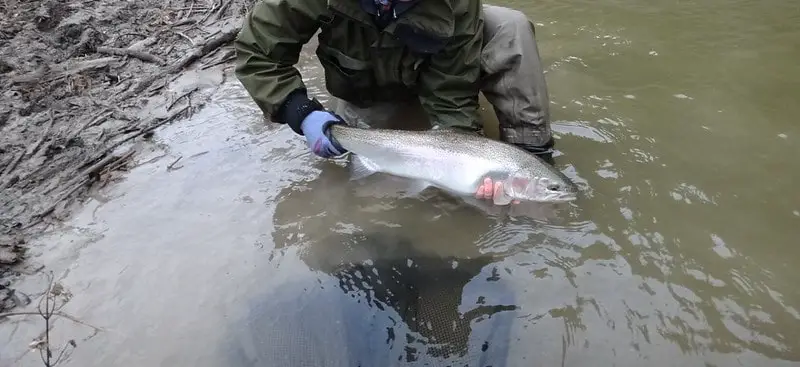
Spring steelhead fishing can go from ice-cold rivers in late February to steelhead up on the spawning beds in late March and steelhead dropping back to the lake in April. Good anglers will use multiple methods and different baits to adapt and catch more steelhead.
The fishing method for spring steelhead that other guides and I use will help you catch more steelhead during the three stages of the spring steelhead runs. I adapt and fish them differently to ensure my clients are catching the most steelhead possible, and so should you.
The Three Stages Of Spring Steelhead Fishing
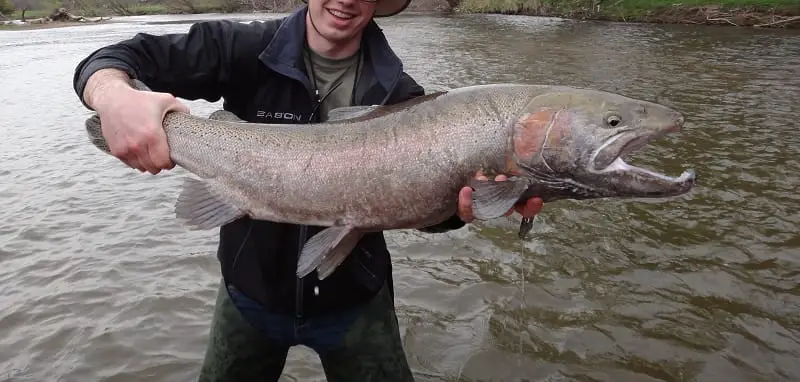
I break the spring steelhead runs into three different stages to help my clients know what to use, and where and when to fish.
Stage one is during late winter and early spring when the ice and snow around many rivers start to melt. This melting raises the river levels and can trigger the first runs of spring steelhead.
On many rivers around the southern Great Lakes region, the first spring steelhead runs usually occur in late February and early March. For anglers fishing in upper Michigan, Wisconsin, or the north shore of Lake Superior, the steelhead runs can be delayed by 2 to 4 weeks because of the colder climate.
However, in some warmer years, like this year, 2024, anglers are seeing plenty of steelhead entering the river in January and February.
There are a lot of steelhead in the river in the spring because you have fresh-run fresh fish mixed in with winter and summer-run steelhead that have been holding in parts of river all winter.
Stage one steelhead are fresh in from the lake, they are aggressive and will readily grab a well-presented bait, fly or lure.
Stage one steelhead are often caught in the pools since they move through rapids and shallow sections quickly.
Stage two steelhead are steelhead that are up on the spawning beds and are actively spawning. Steelhead that are on the spawning beds rarely eat, they fight poorly, and they are not great for harvesting.
Steelhead on the spawning beds are often in shallow water and are easily seen by anglers. Because they are in shallow water, they can see anglers coming from a long way away, and they can be easily spooked, which is another reason that they do not eat. Most steelhead caught on the spawning beds are caught by snagging them.
Steelhead on the spawning beds should be left alone, and anglers should target steelhead in stage one and stage 3 instead. Doing so usually means a lot more fish.
Stage three steelhead have already spawned and are resting and recuperating in the pools, or they are slowly working their way back to the lake. These steelheads are often called drop-backs or drop-downs, and they are often hungry and aggressive.
These drop-back steelhead will sometimes sit in the pools behind spawning steelhead and gorge on eggs. Anglers should avoid spawning steelhead and focus on these steelheads instead.
Stage 3 steelhead are often caught in the pools, but I have had excellent success fishing for them in the fast runs, rapids, and behind rocks.
GUIDE TIP: While other anglers are having a tough time fishing for spooked steelhead in the pools, I will often try to find single steelhead holding in pockets in the faster water.
Timing The Runs
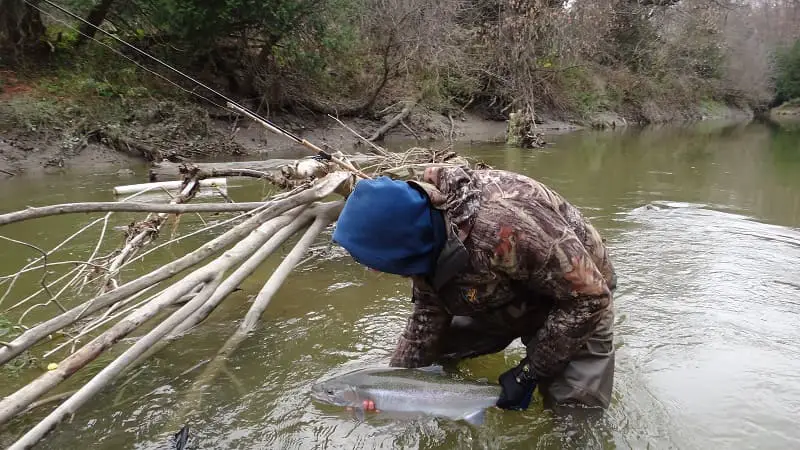
Anglers and guides who know how to time the runs can be on the rivers when the steelhead fishing is at its best.
Steelhead usually run when rivers rise and start to get dirty. Rising water draws the steelhead in from the lake, helping them navigate through very shallow sections and over dams and other obstructions.
High water also helps them get further up the river to the best spawning grounds. The downside to high water on many tributaries around the Great Lakes is that the river will go muddy. Some anglers describe this dirty water as “chocolate milk.”
When the water is super dirty, the steelhead can’t see your baits, making it almost impossible to catch any steelhead. When I contact my guides or friends to find out about river conditions, I often don’t care about the height or speed of the river. All I care about is the clarity.
I can catch steelhead in high and fast water if it’s clear, but not in muddy water.
I tell my clients that if I stand in ten inches of water and can’t see the tops of my boots, it’s probably too dirty to fish.
I can probably catch fish if I can see the bottom in 10 to 12 inches of water. With twelve inches of clarity, you must get your bait within 12 inches of the fish. 14 to 20 inches of clarity is when the steelhead fishing can be fantastic.
Anglers who know what they are doing know that as the rivers start to drop and clear, it is the best time to hit the river.
I use the online USGS Stream flow charts to help me determine fishing conditions and water clarity and color before I leave the house. I discuss my methods for reading the data at Stream Flow Data Related To Fishing.
Spring Fishing Methods
The methods that you use to catch spring steelhead are often a personal choice since all the methods I discuss below will work. The problem that I see anglers making with most of these methods is not setting up their rig properly, not fishing it properly, or using the wrong baits or lures at the wrong time.
Float Fishing For Spring Steelhead
Float fishing is effective and popular everywhere. Float fishing is best done in pools, on deeper rivers, and in slower water. Float fishing is simply suspending a bait below a float.
The honest truth is that if float fishing is done poorly or is set up wrong, or you use the wrong floats, line, leaders, and hooks, you will struggle to catch steelhead.
If you want to improve at float fishing, check out my page, Float Fishing For Steelhead.
Centerpin Fishing For Spring Steelhead
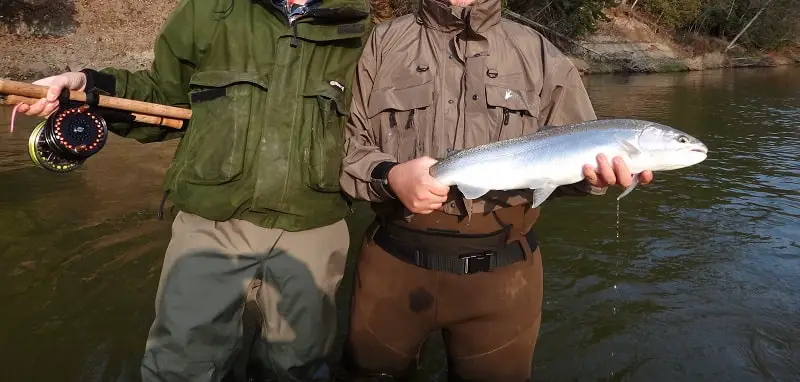
Centerpin fishing is the same as float fishing, except with a Centerpin reel. The Centerpin reel combined with an extra-long rod gives you the advantage of getting the best presentation possible.
After using and teaching anglers how to float fish with a spinning reel and Centerpin reels, I can honestly say that the Centerpin reel is superior and can’t be beaten.
For more information on my guide tips and advice on Centerpin fishing for steelhead, trout, or salmon, check out my page Centerpin Fishing For Beginners: 20 Steps From A Top Guide
Fly Fishing For Spring Steelhead
Fly fishing is my favorite way to catch steelhead on most rivers around the Great Lakes, except for huge, deep rivers.
Fly fishing for steelhead can be done effectively using nymphing, Euro nymphing, or Spey fishing. For detailed information about fly fishing for steelhead, check out my page, Fly Fishing For Steelhead: Great Lakes Style.
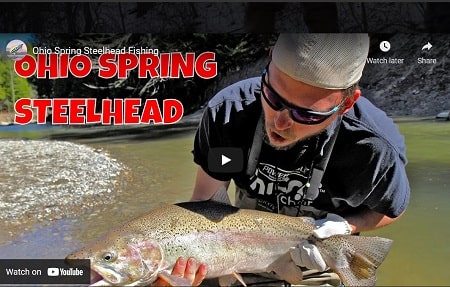
Nymphing with an indicator is the most popular and effective method.
I use this a lot with beginner clients or when fishing larger, deeper, or slower sections of the rivers.
For more info, check out my page, Nymphing For Steelhead: The 3 Most Effective Methods
Euro Nymphing for steelhead is something that many anglers haven’t even heard of yet, but it’s often my most effective method on smaller sections of rivers or in fast shallow water and in pocket water.
If you think Euro Nymphing is something you want to try, or you want to know more about it, check out my page, Euro Nymphing Steelhead.
Bottom Bouncing / Drift Fishing For Spring Steelhead
Bottom bouncing and drift fishing are very similar. I use these methods with spinning reels. The idea is to cast the bait out and then let it drift freely down the river with the current. It does not use a float.
The tricky part for most anglers is detecting a bite and controlling the speed. For my advanced methods, check out my page Bottom Bouncing – 5 Proven Guide Tips For More Fish.
Lure Fishing For Spring Steelhead
Some anglers like to use lures which is a good option as the water starts to warm.
Some of my favorite lures for spring steelhead are:
- Spinners
- Spoons
- Crankbaits
- Plugs like Maglips and Kwickfish
- Jigs. Yes, I said jigs! Jig fishing for steelhead can be very effective at times.
For all the details on the best lures, sizes, colors, and how to fish lures, check out my page Best Lures For Steelhead – A Pro Guides Recommendations.
Some anglers might also find my page Spin Fishing For Steelhead – 5 Most Effective Methods Used By Guides very informative.
Best Baits For Spring Steelhead
The best baits for spring steelhead are spawn bags, worms, beads, and flies. I will change my baits, the sizes, and the colors depending on the conditions.
In dirt water, I will use larger and brighter baits like ping pong ball-sized spawn bags in chartreuse color. In very low water, I prefer a natural-looking stonefly nymph or a single egg pattern. It’s important to know what bait to use and when.
I have found that my method of rotating baits has been exceptionally effective at putting my clients onto fish when other anglers are not catching anything. I even have certain baits that I use when the fish are pressured by other anglers.
I discuss my tips and tactics on my page Best Steelhead Baits And How To Maximize Their Effectiveness.
I also have two great articles on Fall Fishing For Steelhead and Winter Fishing For Steelhead, so be sure to check them out.
Tight Lines,
Graham

Hello Graham, I keep reading and rereading your tactics as they are great. I am new to steelhead fishing and an older guy and rig the float setup as you recommended but I have an issue. In the field, tying a new leader on to a micro swivel is near impossible with my aging eyes and is challenging at home too. I would like to just tie a 3 foot ( 8 or 10 pound sufix 832) or so leader suspended below a 50 pound swivel and attach split shot to the upper portion of that. I realize that I will lose all of the leader on a good snag but maybe better than having to go home not being able to tie onto those micro swivels. your thoughts would be appreciated. Mark